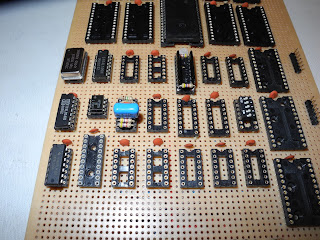The original TS2 computer design used 2764 8Kx8 EPROMs for read-only memory. There are four, providing a total of 32KB of ROM. The 2764 type were popular at the time the board was designed, providing a good tradeoff between cost and storage capacity.
These are EPROMs - Erasable Programmable Read Only Memory, programmed using a device programmer which provides the correct timing including a programming voltage (12.5V for these particular devices). They can be erased using an ultraviolet lamp. Erasing sets all bits to ones.
I'm also planning to support 28C64 EEPROMs which are electrically erasable. The device programmer can erase them electrically in a few seconds. You can also write to them in-circuit, but not typically at full speed (you need to wait a short time before subsequent writes).
Because the chips are 8 bits wide and the 68000 has a 16-bit address bus, pairs of ROMs are used -- one for even addresses (D0-D7) and one for odd addresses (D8-D15). There are four sockets on the board, but the TS2 monitor is less than 16KB in size and will fit in one pair of chips.
When you program them you need to split the data into even and odd data. You can either do that when creating the download files, or many ROM programmers can do it directly as an option when loading the files.
My
monitor source code when assembled generates Motorola S record files. I added rules to the make file to generate odd and even download files.
My programmer is a low-cost
Willem GQ-4X which can program various types of devices,including 2764 EPROMs and 28C64 EEPROMs. The software can perform splitting into even or odd data if desired.
I programmed a pair of 2764 EPROMs and also a pair of 28C64 EEPROMs in preparation for testing the board once it gets assembled.
To erase EPROMs, I have a low cost UV eraser which I bought on eBay. It will erase the devices in about 20 minutes.
Incidentally, the RAM on the system uses 6264 8x8K static RAM chips which have almost the same pinout as the EEPROMs. Four sockets are provided, supporting a total of 32KB of RAM.


















